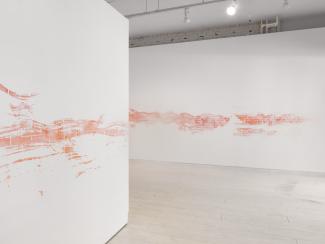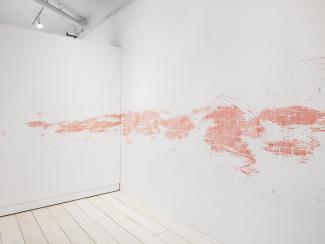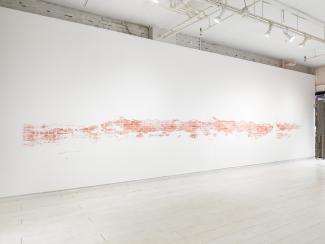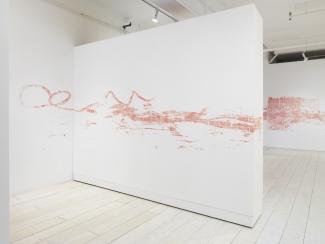“Crucially, then, we should understand phenomena not as objects-in-themselves, or as perceived objects (in the Kantian or phenomenological sense), but as specific intra-actions.”[1]
— Karen Barad
With his exhibition Nonlocal, Brody Albert takes the vocabulary of quantum physics and engages it with a visual scene not-from-here. In a poetic consideration of co-constructed phenomena, the walls of Access become indexical of a place and time that is both here and there; indicative of the intra-activity that produces material reality. A wasp nest and a dirty freeway tunnel wall provide the basis for a meditation on how the physical world is a result of numerous collaborating forces—on both macro- and microscopic levels. We are left with the product of these intra-actions; the communal mark-making of a multitude of knowing and unknowing participants, an index of togetherness, and of the webbed reality within which we are all enfolded. As an artist working in a material-centered practice, Albert exhibits in this instance a reckoning with materiality itself.
‘Nonlocal’ is a quantum physics term that describes the way in which quantum particles are inherently linked through their entangled movements, even across vast distances. Related is the term intra-activity, introduced by American physicist and feminist-theorist Karen Barad in her book Meeting the Universe Halfway (2007). If interactivity indicates individual entities responding to one another as separate beings, intra-activity recognizes “their ontological inseparability.” [2] In older theories of physics, matter was understood to be made up of tiny particles that, while attracted to one another, existed in a separate, individual way. Intra-activity, by contrast, speaks to the actions of a teeming, inseparable mass of snarled and knotted entities, so closely linked with one another that they share their very existence.
Einstein called this phenomenon “spooky action at a distance.” The phrase has captured the minds of artists, curators, philosophers, and cultural theorists in recent years; regardless of the fact that even physicists are still perplexed by the phenomena—while this behaviour has been demonstrated and observed in experiments, there are currently no formulas, or proven theories to explain them. This field of study presents a new way of understanding materiality, and as it upends traditional conceptions of how the physical world is organized, it simultaneously proposes a cognitive alternative to the fracturing, isolating forces of late capitalism, colonial logic, and Enlightenment rationality. In his book Hyper Objects (2013), Timothy Morton states,“if biology discovers how entangled life forms are, quantum entanglement opens a more profound interconnectedness,”[3] and further on that, “you aren’t part of a larger whole. Everything is enfolded in everything as ‘flowing movement’.”[4] That is, to be ‘a part of’ something still indicates some separability. Quantum entanglement proposes instead that everything is everything; a reality wherein even the most quotidian of objects are the result of myriad collaborating forces.
Albert looks specifically to such everyday objects to ruminate on the complex conditions of their making. His meticulously fabricated works speak to the social, economic, and cultural features of the object's original context; indexical of their real-world subjects, yet increasingly divergent with the passage of time. With Jacket Burn (110 at I-5), the walls of Access have been coated with a 1:1 stenciled negative of the soot-covered tile surface on an L.A. freeway tunnel wall; marked-up by passersby over time as they walk along the narrow sidewalk. What has been removed from the tunnel wall is transposed to that of the gallery in rose chalk. One can trace the movements of unknown individuals from some 1,700 kilometers away through this record. [5]
In our email correspondence, Albert listed just some of the forces responsible for this site: “the L.A. freeway system, the multi-year soot build up from car exhaust, the wind direction which pushes the exhaust through the tunnel, the narrow sidewalks, the emergencies that forced a countless number of people to walk through the tunnel which removed the soot from the wall, and so on.” Attached to this list are the economic and cultural forces that determine freeway system planning; the location and demographic of the communities which the freeways connect (often organized by race and class); the factory processes, conveyor belts and many hands (both machine and flesh) that construct vehicles; the extraction of minerals to form steel bodies, asphalt strips and white-tiled walls; the socio-economic disparity between driver and pedestrian in that tunnel… The list could spiral out endlessly, and is a macroscopic example of how intra-activity determines the life and course of matter.
Wasp Nest (Mr. Horsepower) references collaborative action from a very different context. A wasp nest’s form is determined primarily by the support to which it is attached, and by the movement of wasps circling around their queen, located in the centre. As a social insect, their nests are constructed by hundreds, sometimes thousands, of workers. Once it has served its purpose, the delicate nest is abandoned by its occupants and exposed to the elements. Though appearing as physical copies of one another, the nest that in the gallery and its referent live out different lives, aging at different rates under different conditions. In a similar way, new layers of soot accumulate on the tunnel wall in question; meeting the brushing-by of new shoulders, backpacks and sleeves (while editing this text, I have been informed that the walls were recently power-washed by the city). Moreover, the act of translation leaves its own stamp. Wasp Nest (Mr. Horsepower) is constructed in a strata of recycled Xerox paper, its rendered body marked by digital-cutting traces; while the bitmap pixels of Jacket Burn (110 at I-5) create a translation that is precise, yet sterilized. True verisimilitude is not achieved, and the art-object therefore references something unstable; a place and time which is still present and already past.
It is precisely this time and distance which forms the conceptual relationship to nonlocality in Albert’s exhibition. These terms—nonlocality, intra-action, entanglement—provide a vocabulary through which a radical shift in the world’s organizing structures might be discussed. Albert takes up this language and places it in a visual context to consider the ways in which the very physical structures that constitute our surroundings and our beings are inherently, essentially part of one another. The resources we extract, the roads we drive on, the paper that makes up a wasp nest, are created through the intra-actions of a teeming, collective, enfolded mass of particles and beings to which everything belongs. In this radical nonlocal reality, all things are ravelled within one another.
Catherine de Montreuil











